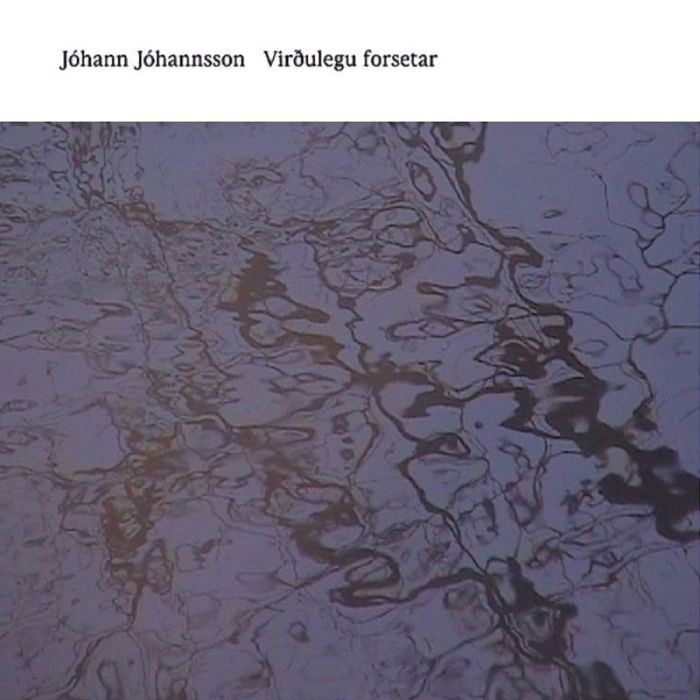Virðulegu Forsetar by Jóhann Jóhannsson (Review)

Although I liked Jóhann Jóhannsson’s previous disc, Englabörn, a fair amount, I didn’t get into it quite as much as others I knew. Perhaps that was because its blend of lush string arrangements and modern electronics felt a little too — and I use this term only because I can’t think of anything better — gimmicky. No such complaints, however, with Virðulegu Forsetar, the man’s latest work.
For this composition, Jóhannsson largely eschews the electronics and string arrangements, instead using focusing his music around trumpets, tubas, and other brass instruments. While the piece is ostensibly for brass, organ, piano, electronics, percussion, and piano, it is the brass instrumentation that remains the piece’s foundational element, their golden swells and tones lending a majestic, and melancholy, tone to the entire piece.
Listening to the four untitled movements that make up Virðulegu Forsetar, I’m greatly reminded of Arvo Pärt’s stately minimalism. Although Jóhannsson’s music isn’t quite as sparse as, say, Pärt’s Spiegel im Spiegel, there is still the same sense that each and every note you hear has been placed with precision, and more importantly, each stretch of silence is has been created with precision as well.
As the listener passes through the disc’s movements, they hear the same theme played by the brass section, with minor adjustments, slowing down as it goes. The horn swells grow grander and more drawn out, creating moments that are triumphant in their sadness and majesty. Although the piece wasn’t created as a memorial of any kind — Jóhannsson lists, among other things, entropy, Pynchon’s The Crying of Lot 49, Nietzche’s “Eternal recurrence,” and Moebius strips as his sources of inspiration for the piece — it’s next to impossible not to hear these elegiac movements as fanfares and funeral pieces.
That’s not to say that Virðulegu Forsetar is a depressing, overbearing piece of music. Far from it. But there is something of a sadness, and an oldness to it (despite being composed just a few years ago), as if the piece had been composed for some long-forgotten tragedy. Because of the piece’s pacing, and its reliance on silence and space as much as instrumentation, it is a very reflective and meditative piece.
Despite the movements ranging from 14 to 21 minutes in length, the slow pace and ultra-minimal structure plays with one’s sense of time. Indeed, time doesn’t even seem to exist within these structures, or if it does, it’s quickly gotten lost amidst the expansive space these pieces reveal themselves to inhabit. As a result, the listener begins to feel as if they’re unstuck or suspended, buoyed up only by Jóhannsson’s arrangements — the keening notes of a trumpet, the soft drone of an organ, the barest shimmer of piano.
The first I listened to the disc, I listened to it on headphones at work, and was very nearly overcome right there at my desk. While there are no huge climaxes à la Gorecki’s Symphony No. 3, there is definitely a cumulative effect. Slowly, but surely, the piece’s gentle pace, the soft ebb and flow of the horns, and the distant drones begin to surround and overwhelm you. Not in a claustrophobic manner, but rather it feels like something bigger and grander than you could ever have imagined is slowly being revealed to you, making you feel a little smaller and less significant than before.
Altogether, it’s an absolutely gorgeous piece, a highly evocative composition that is both joyful and uplifting, infinitely sad and haunting. It easily ranks up there with the works of Pärt, Gorecki, and Gavin Bryars — not to mention Jóhannsson’s fellow Icelandic composer, Hilmar Örn Hilmarsson.
Note: This is actually a two disc release. The first disc is a normal stereo CD, the second is a DVD-Audio hybrid that contains a high resolution 5.1 surround sound mix of the piece. The first performance of Virðulegu Forsetar took place in Hallgrimskirkja, a large church in Reykjavik, with the performers placed throughout the room, to create an immersive experience for the audience; as a result it was named “the most memorable musical event of 2003” by Iceland’s leading newspaper. The 5.1 mix is an attempt to recreate that spatial listening experience for home listeners.